|
Excerpts
From the Introduction to Bicycling Cuba
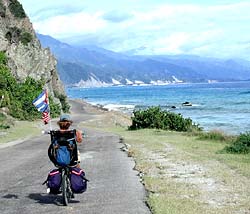 *
* * * *
* * *
If
you have never visited Cuba, you will be astonished by its sheer size,
diversity, and beauty. The distance by road from one end of Cuba to
the other is about the same as that between Vancouver and Calgary in
Canada or between Chicago and New York City in the USA - 1000 kilometers!
There are hundreds of kilometers of flat or gently rolling lowlands,
lofty mountain chains, and countless tropical beaches. During most of
the year, the climate is ideal for cycling, and the scenery is stunning.
There
are more reasons to tour in Cuba than scenery, beaches, and climate.
Cycling is the ideal way to learn about a country and its people, and
there are few places more worthy of knowing than Cuba. The people are
renowned for their warmth, hospitality, and sense of fun. Just as the
colors of the Cuban people range across a spectrum from the fairest
blonde of northern Europe to the darkest hue of Africa, so their music,
art, and dance are a unique harmony of European and African cultures.
The
last 100 years of Cuban history have been a continuous, often inspiring
struggle for independence, and since the 1950's Cuba has been the site
of a revolutionary social and political experiment. There is a great
deal to learn from Cuba's history, from the revolution's admirable achievements,
and from its problems as well.
Cuba
is uniquely friendly to cyclists because of the role that bicycles played
during a decade of difficulties. For about 30 years, from the early
1960's to the early 1990's, Cuba escaped the worst effects of a punishing
U.S. embargo through preferential trade agreements with the Soviet Union
and the Warsaw Pact nations. Then, with the collapse of the Soviet Union,
aid and trade ended, oil shipments ceased, lights dimmed, transport
ground to a halt, and the economy went into free fall. In the 1990's,
Cubans endured the so-called special period, a time of genuine
hardship from which the country is s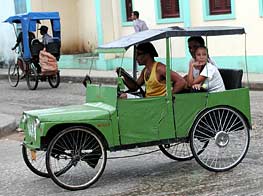 till
emerging. When gasoline was unavailable during the special period,
Cubans turned to bicycles. Hundreds of thousands of clunky but nearly
indestructible bikes, the ubiquitous Flying Pigeons, were imported from
China, and Cuba soon had its own bike factory. Within a few years, millions
of Cubans were traveling on two wheels. Driven by necessity, it was
perhaps the fastest, most thoroughgoing transformation in the transportation
system of any country in the world. till
emerging. When gasoline was unavailable during the special period,
Cubans turned to bicycles. Hundreds of thousands of clunky but nearly
indestructible bikes, the ubiquitous Flying Pigeons, were imported from
China, and Cuba soon had its own bike factory. Within a few years, millions
of Cubans were traveling on two wheels. Driven by necessity, it was
perhaps the fastest, most thoroughgoing transformation in the transportation
system of any country in the world.
In the new millennium, the economy is
improving, and more cars and trucks are on the road. Still, millions
of Cubans continue to ride bicycles, and even the small minority who
drive today depended on bikes yesterday. As a result, motorists accept
the right of cyclists to share the road, and they are remarkably courteous.
In 8,000 kilometers of cycling in Cuba, we never felt threatened by
a hostile motorist; on the contrary we were impressed by the patience
of Cuban drivers who typically stayed well behind until they could pass
us safely.
There
are thousands of kilometers of lightly-traveled, paved roads in Cuba,
and while the condition of pavement in rural areas is not always perfect,
it is good enough for enjoyable cycle touring. Because bicycling is
important for so many average Cubans, there are conveniences for cyclists
including designated bike lanes on major roads, parqueos where
bicycles can be left safely for pennies, and poncheras, small
businesses that fix flats and do minor repairs. If you travel by automobile
or tour bus, you are cut off from the people by glass walls of wealth,
but when you ride a bike, just as Cubans do, human contacts are natural
and easy. Cycling is without a doubt the best way to see Cuba.
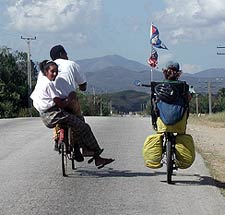 We
hope this book will make it easier for you to experience Cuba on your
bike. When we began riding in Cuba, there were no cycling guides at
all, and the available maps were often inaccurate. On many a day's ride
we did not know how soon we would find food and water or where we would
spend the night. We were often lost, or worried that we might be lost. We
hope this book will make it easier for you to experience Cuba on your
bike. When we began riding in Cuba, there were no cycling guides at
all, and the available maps were often inaccurate. On many a day's ride
we did not know how soon we would find food and water or where we would
spend the night. We were often lost, or worried that we might be lost.
Today
a reasonably good, complete set of maps is available in Cuba, but it
still omits much information essential to cyclists about road conditions,
grades, and availability of food, water, and accommodation. Plenty of
general-purpose guidebooks are on the market, but any route directions
they contain are designed for motorists. They are not detailed and precise
enough for cyclists ...
*
* * *
We
give detailed descriptions of routes and landmarks
that will help you ride in Cuba with confidence. We provide specifics
on the availability of food and bottled water, and we often recommend
accommodation. Also, we try hard to let you know what the experience
of cycling Cuba is really like ...
*
* * *
Freedom,
Personal Safety, and Security
Many North Americans are under the misapprehension
that travel in Cuba is heavily restricted, that tourists are only allowed
to visit places the government wants them to see. This is entirely mistaken.
In fact, you can get on your bike (or rent a car for that matter) and
go anywhere at all. The only exceptions, obviously, are military bases,
and this kind of restriction applies in any country in the world.
Cuba
does not have a free press, and there are limits on freedom of expression.
This does not mean that you cannot have frank discussions with Cuban
people. The key is to show respect for their government and political
system even though its principles may be different from those to which
you are accustomed. If you arrive already confident that you understand
Cuba's problems, you will not learn much while you are there...
*
* * *
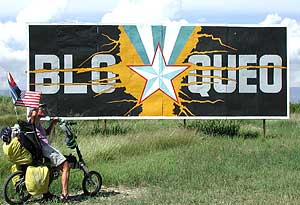 Are
Americans Welcome in Cuba? Are
Americans Welcome in Cuba?
The
U.S. has enforced a punishing embargo against Cuba for more than 40
years and has attempted to prevent other nations from trading with Cuba
as well. The U.S. supported the invasion at the Bay of Pigs, and since
then it has turned a blind eye to the terrorist operations of fanatical
Cuban exile groups based in Florida. Under such circumstances, you might
think Cubans would be hostile to American visitors.
In
fact the opposite is true. Americans are not only allowed to visit Cuba,
they are welcomed with special warmth. This may be due to the "ties
of singular intimacy," to borrow a phrase from historian Louis
Pérez, that have long existed between these two estranged nations.
Before the revolution, many middle class Cubans sent their children
to the U.S. for their education, and it is still common to meet older
Cubans who studied in the States. In the 1940s and 1950s, Cuba and the
southern U.S. were so closely connected that sales in Miami and New
Orleans department stores were regularly advertised in Habana newspapers.
Today, millions of Cubans have relatives in the United States. Cubans
watch videos of U.S movies and television shows, listen to U.S. radio
stations, and Cuban youth are fans of U.S. musical groups. Baseball
is Cuba's favorite sport, by far.
Perhaps
even more important, it seems natural for Cubans to distinguish between
the policies of the U.S. government and the feelings of the American
people themselves. Fidel Castro himself frequently says, correctly,
that the majority of U.S. citizens do not support their own government's
harsh treatment of Cuba or are ignorant of it...
*
* * *
Travel Restrictions
At
press time, the U.S. restricted travel to Cuba by most American citizens,
but not all American citizens. Cuban-born Americans could travel to
Cuba legally under certain conditions. Many other individuals - journalists,
aid workers, and people involved in professional meetings or educational
programs, for example - were licensed to travel there routinely or were
eligible for special licenses to go.
For
other Americans, the situation was more complicated. (Summary of
restrictions at press time follows, together with reliable internet
resources for up-to-the-minute reports on the legal situation.) ...
*
* * *
The Question
The
question people ask us most often about cycling in Cuba is, "What
is it like?" They aren't asking about the road conditions or the
tap water. They are asking a harder question, about people, living conditions,
politics.
It
is almost a cliché to say how friendly and welcoming Cuban people
are, but it is less often said how well educated and informed they are.
We read a comment somewhere that Cuba is a Third World country inhabited
by first world people. There may have been a touch of condescension
in the comment, but the intent was correct. The literacy rate equals
or surpasses developed countries, and Cuba's system of free education
churns out huge numbers of doctors, teachers, engineers, and other professionals.
The
problem is that the stunted economy does not provide enough rewarding
work to match the capabilities of the people.
Cuba's
public health system is also excellent. Despite chronic shortages of
medicine and equipment, key health statistics — infant mortality
rates and life expectancy — match or surpass those of developed
nations.
There
is much poverty in Cuba. You will see homes and public buildings that
are unpainted or poorly maintained, shortages of some ordinary foods
and consumer goods, people forced to mend old clothes and struggle in
many ways to get by on meager salaries. However, in the real Third World,
poverty often means that people do not have homes at all; they watch
helplessly as babies die of malnutrition and curable diseases; children
have no opportunity for education and a better life; people live without
basic sanitation and medical care; they have no hope. This degree of
poverty does not exist in Cuba.
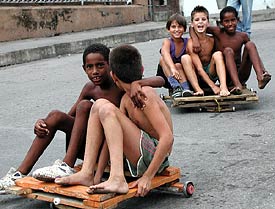 Compared
with nearby Caribbean nations Cuba is doing fairly well, but Cubans
compare themselves with North Americans. Someone who can't find a good
job or even a tire for his bicycle is not comforted by the fact that
Jamaicans or Haitians are worse off. Young people, especially, ache
for greater opportunities and for the consumer goods enjoyed by North
Americans. But widespread dissatisfaction does not imply widespread
opposition to the government. The objective situation and the feelings
of individual people are too complex for most generalizations. Compared
with nearby Caribbean nations Cuba is doing fairly well, but Cubans
compare themselves with North Americans. Someone who can't find a good
job or even a tire for his bicycle is not comforted by the fact that
Jamaicans or Haitians are worse off. Young people, especially, ache
for greater opportunities and for the consumer goods enjoyed by North
Americans. But widespread dissatisfaction does not imply widespread
opposition to the government. The objective situation and the feelings
of individual people are too complex for most generalizations.
We
got to know a family in which both the parents and their two sons were
exceptionally talented, well-educated professionals. The mother said
to us, "We know that our sons, with their education and ability,
could live better in another country, but this is our revolution. We
know there are problems, but we want to make it work." Just down
the street lived another family of professionals in similar economic
circumstances. The father said one day, "I'm too old to leave here
now, but my greatest hope for my son is that he will get out of this
terrible country."
If
there is a fair generalization about the conditions and the politics
of Cuba, it is this: As a visitor, you can see what you expect or want
to see. If you come to Cuba looking for evidence of a police state,
inefficient bureaucracy, and dissatisfied people, you can find it. If
you look for evidence of a uniquely idealistic society in which people
have a strong sense of community, respect their government, and are
trying to solve problems without sacrificing the achievements of their
revolution, you can find that too.
Let's ride.
|



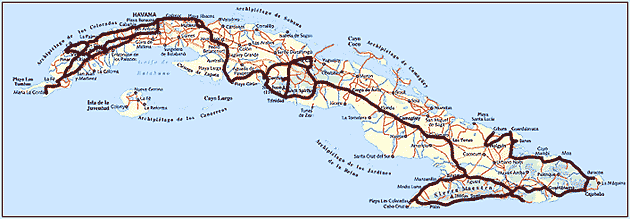
 *
* * *
*
* * * We
hope this book will make it easier for you to experience Cuba on your
bike. When we began riding in Cuba, there were no cycling guides at
all, and the available maps were often inaccurate. On many a day's ride
we did not know how soon we would find food and water or where we would
spend the night. We were often lost, or worried that we might be lost.
We
hope this book will make it easier for you to experience Cuba on your
bike. When we began riding in Cuba, there were no cycling guides at
all, and the available maps were often inaccurate. On many a day's ride
we did not know how soon we would find food and water or where we would
spend the night. We were often lost, or worried that we might be lost.
 Are
Americans Welcome in Cuba?
Are
Americans Welcome in Cuba? Compared
with nearby Caribbean nations Cuba is doing fairly well, but Cubans
compare themselves with North Americans. Someone who can't find a good
job or even a tire for his bicycle is not comforted by the fact that
Jamaicans or Haitians are worse off. Young people, especially, ache
for greater opportunities and for the consumer goods enjoyed by North
Americans. But widespread dissatisfaction does not imply widespread
opposition to the government. The objective situation and the feelings
of individual people are too complex for most generalizations.
Compared
with nearby Caribbean nations Cuba is doing fairly well, but Cubans
compare themselves with North Americans. Someone who can't find a good
job or even a tire for his bicycle is not comforted by the fact that
Jamaicans or Haitians are worse off. Young people, especially, ache
for greater opportunities and for the consumer goods enjoyed by North
Americans. But widespread dissatisfaction does not imply widespread
opposition to the government. The objective situation and the feelings
of individual people are too complex for most generalizations.